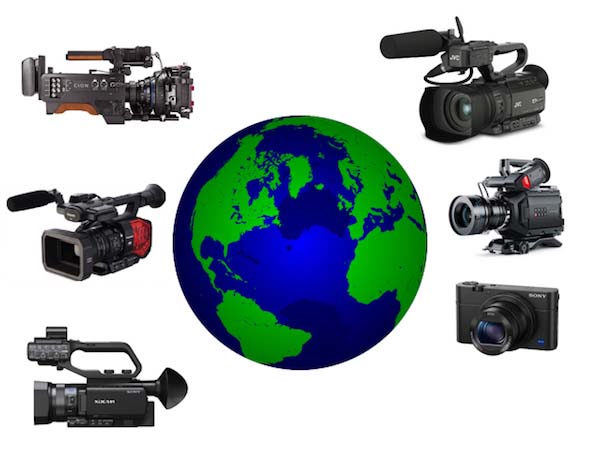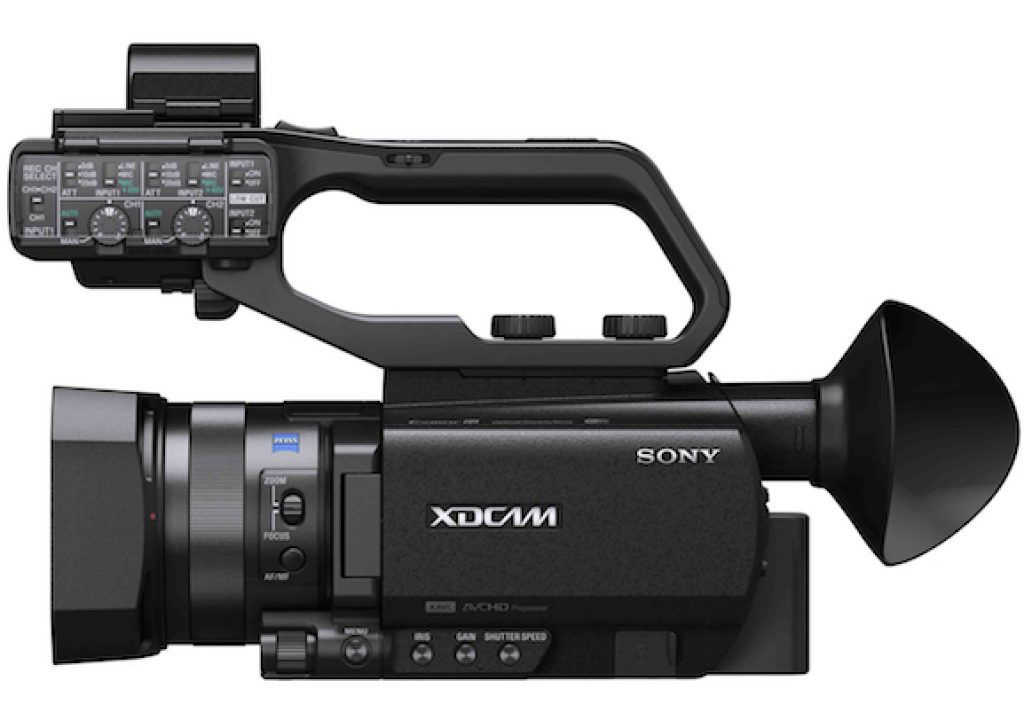
In a recent article, I covered the differences between the words camera, camcorder, streamcorder and worldcam. Fortunately, there are now many excellent worldcam models to consider, from a few hundred to a few thousand dollars. In this article, I’ll review the meaning of worldcam and explain why many of us content producers should never settle for a segregated camera, camcorder or streamcorder ever again, and list some worldcam models from several manufacturers.
Defining the word worldcam
I define a worldcam as a camera that offers all possible framerates, at least in HD and (if available) in 4K. Unlike completely segregated cameras —where you absolutely must buy a separate camera to do 25p and 29.97p, worldcams fortunately offer both in the same camera. They often also ofter the high framerates of 50p and 59.94p (at least in HD), and they may also offer 23.976p and in some cases, exact 24.000p,
although many camera manufacturers unfortunately round the non-integer ones to the closest integer in the menus, as covered in Why I pardon rounding of shutter speeds in camera menus, but not framerates! (illustrated above).
Some examples of worldcams
AJA’s CION is worldcam in all available modes (except in 4K DCI, when it wouldn’t make sense).
All Blackmagic cameras I have ever seen, from the Pocket Cinema Camera to the URSA Mini and original URSA are all worldcam.
JVC cameras like the JVC GY-HM170 and GY-HM200 are worldcam in 4K, in 1080p and in 720p, but not in SD. (Many people produce in 4K or HD and then have the option to distribute SD, so for those situations, the lack of worldcam in SD in the camera is irrelevant.) I wrote about the GY-HM200 here and here, and the GY-HM170 here.
The Panasonic AG-DVX200 with 4/3″ type sensor is worldcam in all modes (except in 4K DCI, when it wouldn’t make sense).
The Panasonic GH4 is worldcam in all modes (except in 4K DCI, when it wouldn’t make sense).
The Sony PVW-X70 with 1″ type sensor is worldcam in all modes. I have written several times about the PVW-X70, the most recent time here.
The amazingly affordable and adorable Sony DSC-RX100 IV with a 1″ type sensor is worldcam in all modes, and its 4K recording performance (at no extra charge) currently beats the PVW-X70’s 4K recording performance after its paid upgrade to 4K.
What’s a segregated camera and why do they exist?
A segregated camera which is intentionally designed to prevent use of certain video formats and/or framerates in certain regions of the world. Originally, in the days of analog PAL and NTSC tube cameras and camcorders, there was a legitimate and natural reason for manufacturers to create segregated cameras, because many of the key components were indeed different among those versions. However, that changed when digital camcorders started to use sensors that could remap the use of pixels of the identical same sensor even for standard definition NTSC and PAL. Although there may have been some prior one, the very first camcorder I ever encountered in 2003 that had that potentiality was the Sony DSR-PDX10, a camcorder which could record either on DVCAM tape or consumer Mini DV (DV25 códec) tape and also offered balanced XLR audio inputs. Back then,I researched and discovered that both the segregated PAL and segregated NTSC versions of the DSR-PDX10 shared the same sensor. However, to my knowledge, Sony never offered a worldcam version of that classic DSR-PDX10.
The first time I heard of an offer to upgrade a camera to worldcam was when Canon did so for the XL-H1 series as well as the XH, XF, and XA (XA10 excluded) series HD camcorders for US$500 in the US and it required sending in the camera and waiting a few days. In the US, this Canon upgrade unlocked the previously inaccessible 25 and 50 fps in the US versions. In Europe, it added the previously inaccesible 23.976, 29.97 and 59.94 fps to the segregated European version. Later, Sony did something similar with its third-generation HDV camcorders, the HVR-S270, HVR-Z5 and HVR-Z7, as I covered in February 2009. This Sony upgrade also required sending the camera, but cost only US$300 including return freight from Sony to the user. Later, in December 2011, Sony announced the upcoming free firmware update to the FS100 to make it worldcam. Previous to that, some higher-priced Sony HD professional cameras including the HDCAM, HDCAM-SR, XDCAM-EX, and XDCAM-HD had all been shipped as worldcam automatically and without extra charge. More recently, some consumer Sony cameras like the DSC-RX100 IV and professional ones like the PXW-X70 were shipped as worldcam automatically at no extra charge. This has been the case with JVC since its HDV cameras (in HD mode) and now continues with its latest GY-HM170 and GY-HM200.
For some strange reason, Canon is not offering worldcam versions of their latest XA35, XA30 and XC10 models, and I have found no indication that they can be upgraded to worldcam later. If you agree with the benefits of worldcam as explained ahead, perhaps you should look instead at some of the many worldcam models offered by AJA, Blackmagic, JVC, Panasonic and Sony shown above in this article. Perhaps someone from Canon will read this and decide to offer free firmware updates for all of their segregated models. If that happens, I’ll certainly write about it 🙂
Caution: Please note that even though many JVC, Panasonic and Sony cameras are worldcams today, not all are. If you are interested in one of their models not listed above, be sure to verify its worldcam status before purchasing.
The only remaining reason for camera manufacturers to offer segregated cameras is to prevent grey marketing. However, many camera manufacturers are finally understanding that user needs weigh more than their antiquated distribution patterns.
Are worldcams identical wherever they are purchased worldwide?
The 100% worldcam cameras themselves are identical. However, their geographic warranty coverage may vary (except with models that are sold with a worldwide warranty); the AC power plug may vary (if one comes included with the camera); the default settings in the menu may vary, and bundled accessories and software may vary. If there is a printed operator’s manual, the language(s) printed may vary too. As indicated earlier, the JVC models mentioned are fortunately worldcam in 4K, in 1080p and in 720p. They are only segregated in SD (standard definition), which would probably only affect a live show where the video mixer doesn’t allow downscaling from HD.
Why are we better off with worldcams?
With a worldcam, you can be hired to shoot by and for a foreign organization that requires a framerate not available in segregated models sold in your country.
I have seen several instances when either raw footage or a complete project needs to be shot or produced at 25p in the US for European distribution. One case is documented in this article: Panasonic AF100 joins forces with Sony encoder for 25p Euro spot in Miami (illustrated above). It is terrible not to be able to accept a foreign video assignment in your own hometown just because your segregated camera prevents it. In fact, that also applies to editing monitors, as I covered in Choose a video monitor for editing & connect it the best way. Although it is true that standards conversion in professional editing systems is simpler, faster and cleaner than ever before, that should always be a last resort, not something you do in ideal conditions. Once you are prepared with your worldcam, you can even offer your services to people throughout the world without reservation.
Image credit
The globe used in the main graphic is in the public domain per Wikipedia Commons, first uploaded by Augiasstallputzer.
(Re-)Subscribe for upcoming articles, reviews, radio shows, books and seminars/webinars
Stand by for upcoming articles, reviews, and books. Sign up to my free mailing list by clicking here. If you previously subscribed to my bulletins and no longer receive them, you must re-subscribe due to new compliance to GDPR. Most of my current books are at books.AllanTepper.com, and my personal website is AllanTepper.com. Also visit radio.AllanTepper.com.
Si deseas suscribirte (o volver a suscribirte) a mi lista en castellano, visita aquí. Si prefieres, puedes suscribirte a ambas listas (castellano e inglés).
Suscribe to his BeyondPodcasting show at BeyondPodasting.com.
Subscribe to his Tu radio global show at Turadioglobal.com.
Subscribe to his Tu salud secreta show at TuSaludSecreta.com.
Subscribe to his award-winning CapicúaFM show at CapicúaFM.com.
Save US$20 on Google Fi, my favorite mobile telephony and data service
Click here to save US$20 on Google Fi, which now works on iPhone and Android. With Google Fi (covered previously in several articles), there is no extra charge for data-only SIM cards on the same account, for up to 10 devices. You only pay for the total data, and data is free after 6 GB per month. So you could be using one Google FI SIM card on your primary phone, another in a tablet or secondary phone (or third, of fourth…).
FTC disclosure
No manufacturer is specifically paying Allan Tépper or TecnoTur LLC to write this article or the mentioned books. Some of the other manufacturers listed above have contracted Tépper and/or TecnoTur LLC to carry out consulting and/or translations/localizations/transcreations. Many of the manufacturers listed above have sent Allan Tépper review units. So far, none of the manufacturers listed above is/are sponsors of the TecnoTur , BeyondPodcasting or TuRadioGlobal programs, although they are welcome to do so, and some are, may be (or may have been) sponsors of ProVideo Coalition magazine. Some links to third parties listed in this article and/or on this web page may indirectly benefit TecnoTur LLC via affiliate programs. Allan Tépper’s opinions are his own.
Copyright and use of this article
The articles contained in the TecnoTur channel in ProVideo Coalition magazine are copyright Allan Tépper/TecnoTur LLC, except where otherwise attributed. Unauthorized use is prohibited without prior approval, except for short quotes which link back to this page, which are encouraged!

